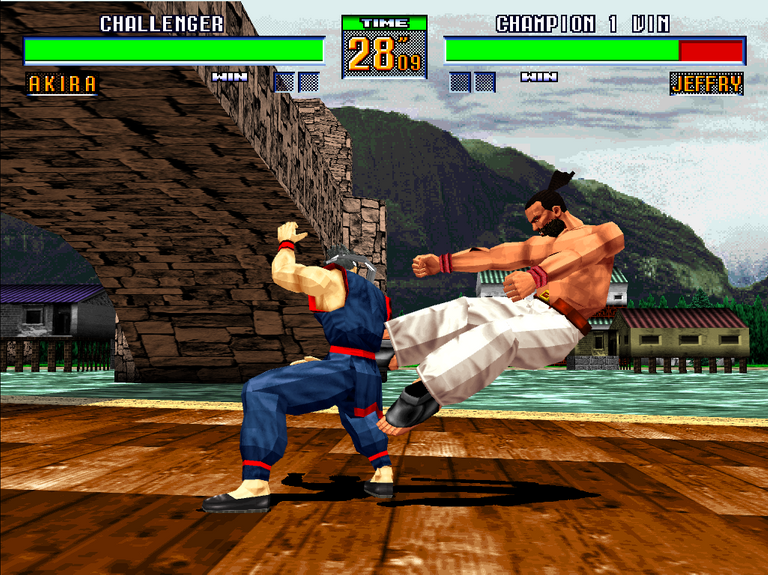

Last time, I talked about the original Virtua Fighter, which was incredibly ambitious and groundbreaking for its time with the real-time 3D graphics and human models on the newly-invented concept of 3D fighting games...but something that always comes up in the gaming industry is how quick it evolves, both in technology and design, and there's nothing that would demostrate this better on this context than its inmediate sequel, Virtua Fighter 2. This game is definitely one of the biggest examples of "easy to learn, hard to master"...in a roundabout way, since while there are commands that will definitely be useful to learn, the biggest challenge is on landing your attacks at the constant risk of getting punished by your opponent.
Powered by the SEGA Model 2 arcade board, capable of pushing 300,000 polygons per second, not only it was more detailed than the first game (with the Model 1 pushing 180,000 poly/sec) in both the characters themselves and the stages, with fully modeled backgrounds instead of a simple picture, but it also allowed for fully textured-mapped polygons and 60fps framerate, making the game look and feel incredibly good; specially if you compare it to the first game. Definitely a big step up that was made in only a single year.
Video of the game running in real hardware by Retro Muel
On the note of attention to detail, while this is more of a novelty, if Jacky and Sarah fight each other in Arcade or in a versus matche (both being siblings and sharing a similar fighting style), the stage will always be a special one set in Chicago instead of a character specific stage. Otherwise, the stages will be in a set order depending of the match in Arcade mode, or simply rotating from stage to stage if playing against another player.
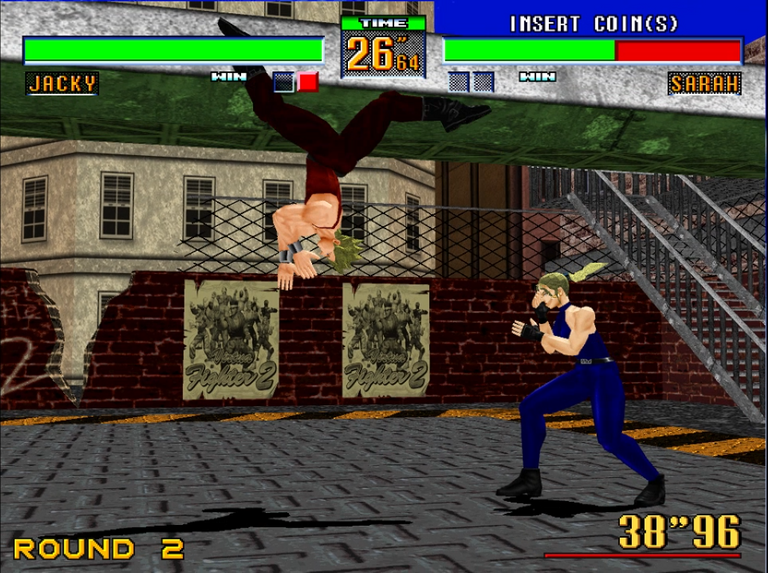
But the overhaul is not limited to just the graphics, as on top of the aforementioned framerate upgrade, the game give you tighter control on your movement and expanded movesets under the same Punch-Kick-Guard button scheme, along side two new characters: The drunken master Shun Di, and the young but cocky Lion Rafale. While side-stepping moves are still rare and moon-jumps are present, this game has been fine tuned to take advantage of the more powerful hardware for a snappier, and steadily solid fighting game.
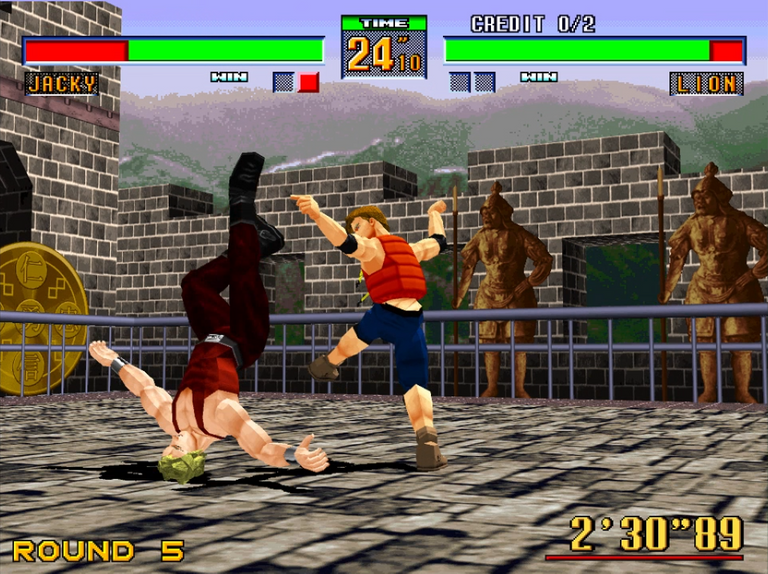
The game feels way faster than its predecessor as a result, as attacks and throws take less time, and it adds to the strategic yet fierce battle that is having to make it or break it under the default 30 seconds of a fight with high-damaging attacks, as well as the Ring Out mechanic still being present in stages, so you can still get your enemy out with sheer pressure, luring or simply by dumb luck.
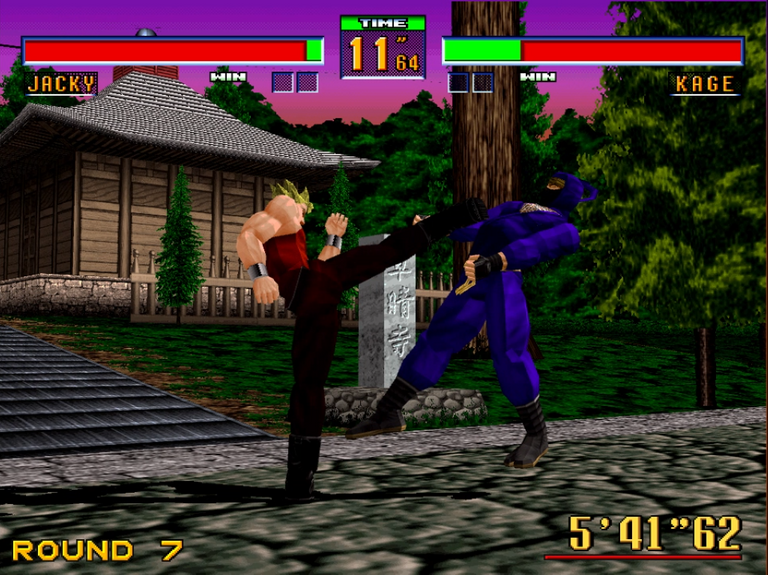
Regarding the single player experience however, you'll fight a specific order of fighters in each match, just like the first game. The arcade version can get tough starting off the fourth fight with Pai (...who also happened to be the difficulty spike in VF1 as the fifth fight), but on top of having 10 fights to go through, as well as the AI being way, WAY harder to defeat after the 6th match (I got stuck for 10 minutes against Kage alone) due to it countering any mistimed attacks instantly (likely input reading, a lot of input reading) and the trick of luring them to the edge and them jump to the other side for an easy Ring Out is out of question...because they will just start backdashing and punish you if you attempt to jump over them (unless THEY are the ones near the edge, putting you at the danger of falling off).
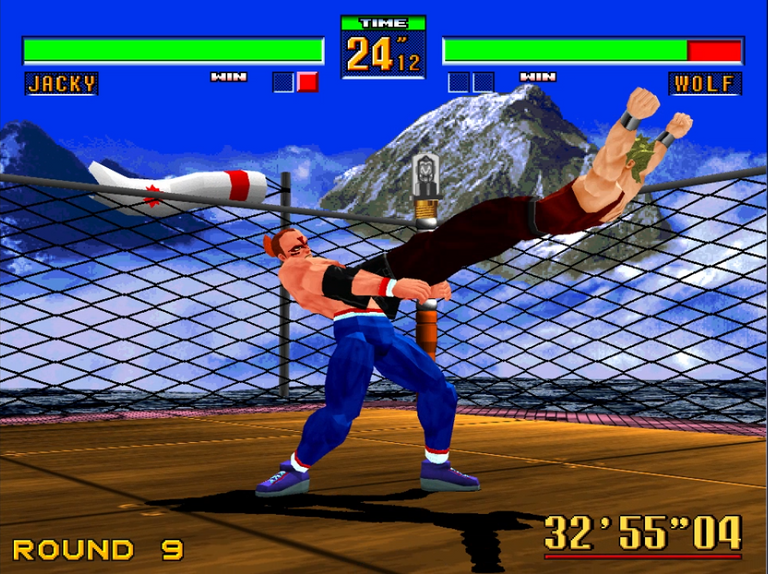
The most unique highlight from playing the arcade mode however is the very end: Just like in VF1, you face a metallic woman named Dural in a bonus fight where you can't continue...but unlike the first game, here you will be fighting underwater on what seems to be the sunken ruins of Atlantis. And yes, what you were fearing just from reading that is also true: The entire fight is in slow motion, making an already hard fight even more difficult...if you don't care about it, then you have finally done it, but if you are aiming to defeat Dural, it will be even more painful than everything else due to the only attempt you got.
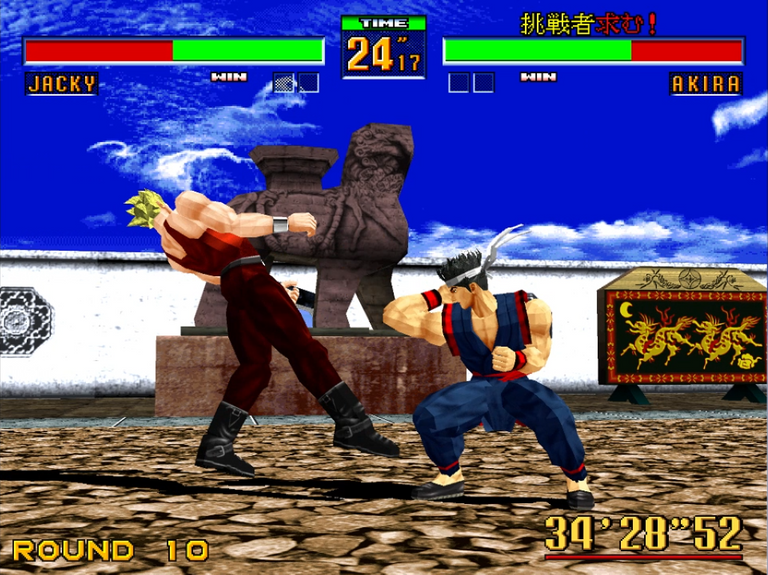
While there had to be a "2.1" revision to fix some few notorious exploits back when released in Arcade, VF2 is an absolute rock-solid game, with an assorted yet balanced cast of fighters, great-looking graphics that holds up today in a certain way from simple polygonal artstyle (and definitely was a huge thing in 1994), and one of SEGA's biggest hits in their history (aside from Sonic) which would gain its reputation through its simple setup yet extremely deep gameplay between your own arsenal and how to defeat a player that's absolutely prepared for anything. And if you are going to try beating this game even in the default difficulty in the Arcade version, you definitely need to be prepared with a lot of practice...or patience.
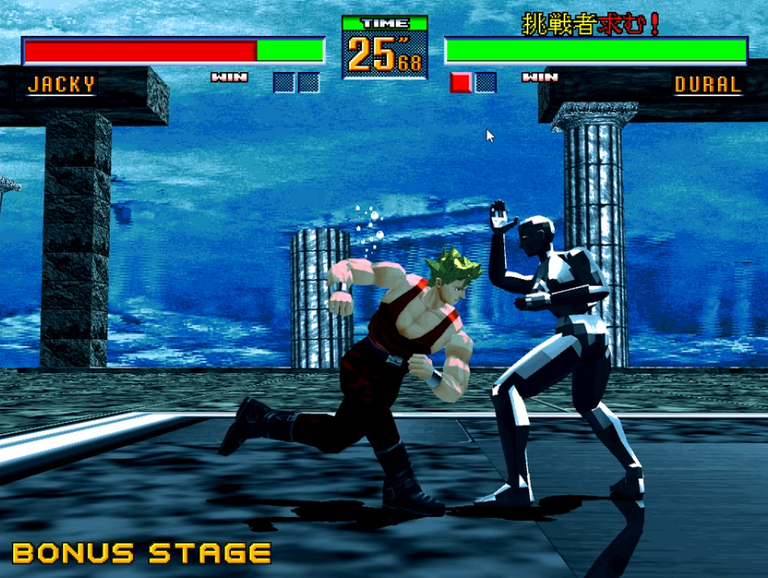
Also, while I'd like to talk about the Saturn/PC port of VF2 one day (since there are some few things added there, but I also want to see if I start talking about "game ports" one day as a sort of new section), it must be mentioned that this game, unlike many other polished yet unfortunate gems that didn't get re-released, got ported to PS2 (exclusively in Japan), PS3 through PSN, X360 through XBLA, and most recently, is featured alongside a couple of other SEGA arcade games as a bonus in the latest Yakuza games (where you'd access them as if you literally were to play an arcade game on a real place). And of course, my recent playthrough and screenshots of it provided here are thanks to using Model 2 Emulator to run the game on PC on its original arcade version.
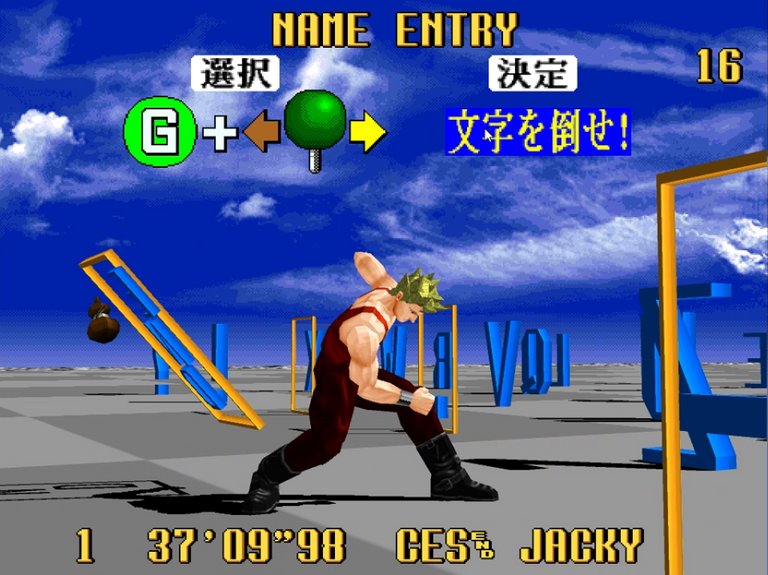
Yes, you have to beat up letters in the Name Entry screen lol

Spanish translation with DeepL. All screenshots were captured by myself.
Español
La última vez hablé del Virtua Fighter original, que era increíblemente ambicioso y rompedor para su época con los gráficos 3D en tiempo real y los modelos humanos en el recién inventado concepto de los juegos de lucha en 3D... pero algo que siempre surge en la industria de los videojuegos es lo rápido que evoluciona, tanto en tecnología como en diseño, y no hay nada que lo demuestre mejor en este contexto que su secuela inmediata, Virtua Fighter 2. Este juego es sin duda uno de los mayores ejemplos de "fácil de aprender, difícil de dominar"... de manera indirecta, ya que si bien hay comandos que sin duda serán útiles para aprender, el mayor desafío está en aterrizar tus ataques con el riesgo constante de ser castigado por tu oponente.
Gracias a la placa arcade SEGA Model 2, capaz de mover 300.000 polígonos por segundo, no sólo era más detallado que el primer juego (con el Model 1 que movía 180.000 polígonos por segundo) tanto en los personajes como en los escenarios, con fondos totalmente modelados en lugar de una simple imagen, sino que también permitía polígonos totalmente mapeados con texturas y una velocidad de fotogramas de 60 fps, lo que hacía que el juego se viera y se sintiera increíblemente bien; especialmente si lo comparamos con el primer juego. Sin duda, un gran paso adelante que se dio en un solo año.
Video del juego en hardware real por Retro Muel
En cuanto a la atención al detalle, aunque es más bien una novedad, si Jacky y Sarah luchan entre sí en Arcade o en un combate versus (siendo ambos hermanos y compartiendo un estilo de lucha similar), el escenario siempre será uno especial ambientado en Chicago en lugar de un escenario específico del personaje. En caso contrario, los escenarios tendrán un orden determinado dependiendo de la partida en el modo Arcade, o simplemente irán rotando de escenario en escenario si se juega contra otro jugador.

Pero la revisión no se limita a los gráficos, ya que además de la mencionada mejora de la velocidad de fotogramas, el juego ofrece un mayor control de los movimientos y una ampliación de los conjuntos de movimientos bajo el mismo esquema de botones Puñetazo-Patada-Guarda, además de dos nuevos personajes: El maestro borracho Shun Di y el joven pero engreído León Rafale. Aunque los movimientos laterales siguen siendo raros y los saltos lunares están presentes, este juego ha sido ajustado para aprovechar el hardware más potente y conseguir un juego de lucha más rápido y sólido.

El juego se siente mucho más rápido que su predecesor, ya que los ataques y lanzamientos tardan menos tiempo, y se añade a la batalla estratégica pero feroz que es tener que hacer o deshacer en los 30 segundos por defecto de una pelea con ataques de alto daño, así como la mecánica de Ring Out sigue estando presente en las etapas, por lo que todavía puede obtener su enemigo con pura presión, atrayendo o simplemente por suerte tonta.

En cuanto a la experiencia para un solo jugador, lucharás con un orden específico de luchadores en cada combate, al igual que en el primer juego. La versión arcade puede ponerse difícil a partir del cuarto combate con Pai (... que también fue el pico de dificultad en VF1 como quinto combate), pero además de tener 10 combates que superar, la IA es muy, muy difícil de derrotar a partir del sexto combate (me quedé atascado durante 10 minutos solo contra Kage) debido a que contrarresta cualquier ataque mal calculado al instante (probablemente lee la entrada, mucha lectura de la entrada) y el truco de atraerlos al borde y que salten al otro lado para un Ring Out fácil está fuera de lugar. ...porque simplemente comenzarán a retroceder y te castigarán si intentas saltar sobre ellos (a menos que sean ELLOS los que estén cerca del borde, poniéndote en peligro de caer).

Sin embargo, lo más destacado del modo arcade es el final: Al igual que en VF1, te enfrentas a una mujer metálica llamada Dural en un combate extra en el que no puedes continuar... pero a diferencia del primer juego, aquí lucharás bajo el agua en lo que parecen ser las ruinas hundidas de la Atlántida. Y sí, lo que te temías sólo con leer eso también es cierto: todo el combate es a cámara lenta, lo que hace aún más difícil un combate ya de por sí duro... si te da igual, al final lo has conseguido, pero si tu objetivo es derrotar a Dural, será aún más doloroso que todo lo demás debido al único intento que tienes.

Aunque tuvo que haber una revisión "2.1" para arreglar algunos fallos notorios cuando se lanzó en Arcade, VF2 es un juego absolutamente sólido, con un elenco de luchadores variado pero equilibrado, unos gráficos de gran calidad que se mantienen hoy en día gracias a su sencillo estilo artístico poligonal (y que sin duda fue un gran éxito en 1994), y uno de los mayores éxitos de SEGA en su historia (aparte de Sonic), que se ganó su reputación gracias a su sencilla configuración pero extremadamente profunda jugabilidad entre tu propio arsenal y cómo derrotar a un jugador que está absolutamente preparado para todo. Y si vas a intentar vencer este juego incluso en la dificultad por defecto en la versión Arcade, definitivamente tienes que estar preparado con mucha práctica... o paciencia.

Además, aunque me gustaría hablar del port de Saturn/PC de VF2 algún día (ya que hay algunas pocas cosas añadidas allí, pero también quiero ver si empiezo a hablar de "ports de juegos" algún día como una especie de nueva sección), hay que mencionar que este juego, a diferencia de muchas otras joyas pulidas pero desafortunadas que no fueron reeditadas, fue portado a PS2 (exclusivamente en Japón), a PS3 a través de PSN, a X360 a través de XBLA y, más recientemente, aparece junto a un par de otros juegos arcade de SEGA como extra en los últimos juegos de Yakuza (donde se accede a ellos como si se tratara literalmente de un juego arcade en un lugar real). Y, por supuesto, mi reciente playthrough y las capturas de pantalla del mismo que se ofrecen aquí son gracias al uso de Model 2 Emulator para ejecutar el juego en PC en su versión arcade original.

Sí, hay que golpear las letras en la pantalla de Name Entry lol

Traducción al español hecha con DeepL. Todas las fotos capturadas por mí.